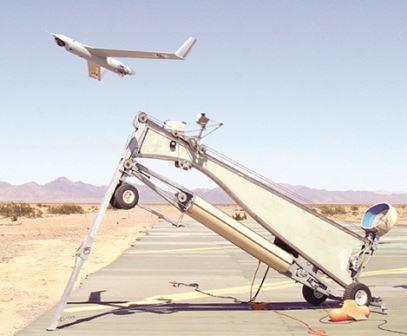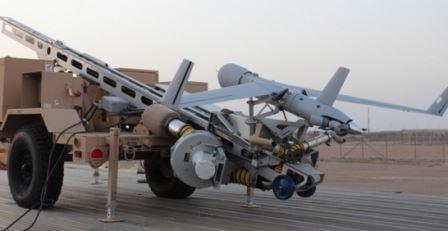ScanEagle UAS
The ScanEagle unmanned aerial system has been
used by U.S. forces in Afghanistan and is being fielded to selective
Afghan National Defense and Security Forces (ANDSF) as well.

ScanEagle (Photo
USAF 2008 SGT Deanda)
Websites with info on ScanEagle UAS
Boeing Insitu ScanEagle - by WikipediA
https://en.wikipedia.org/wiki/Boeing_Insitu_ScanEagle
ScanEagle Unmanned Aerial Vehicle. Boeing
Aircraft
www.boeing.com/history/products/scaneagle-unmanned-aerial-vehicle.page
ScanEagle System - Insitu, Inc.
www.insitu.com/systems/scaneagle
Scan Eagle - USAF Fact Sheet (Nov 1, 2007)
www.af.mil/AboutUs/FactSheets/Display/tabid/224/Article/104532/scan-eagle.aspx

ScanEagle UAV on Launcher
Facts and Figures about ScanEagle UAS
This UAV provides persistent imagery via a live
video feed. The footprint needed for this portable system is small and
it requires no nets or runway. The length of the UAV is about 5 feet and
the wing span is about 10 feet. It weighs about 35 pounds and can carry
a payload of about 7 pounds. It can loiter above the battlefield for
almost 24 hours with a service ceiling of 15,000 feet. It can travel at
80 knots max; and cruise at 50-60 knots.
The ScanEagle saw its first deployment on the
battlefield in Iraq in 2004 with the U.S. Marines. The Air Force
provided it to some of its Security Force Squadrons in a Force
Protection role. Since that time it has been introduced to Afghanistan
as well. It has been fielded to the Marines, Navy, Air Force, Coast
Guard, Army, and various units of U.S. Special Operations Command. Other
nations - including Malaysia, Czech Republic, Singapore, Spain, Italy,
Japan, Netherlands, United Kingdom, Yemen, Colombia, UAE, Poland, Iraq,
Canada and Australia - have used the ScanEagle. Many of these countries
have used the ScanEagle in Afghanistan. 1.
The ScanEagle fills the gap between the
mini-drones like the hand-launched Raven UAV and the runway-launched
Shadow UAV fielded to U.S. Army brigades.
System Description. A complete ScanEagle system
costs about $4 million and is sometimes comprised of four air vehicles,
a ground control station, remote video terminal, a launch system, and
the Skyhook recovery system.
ScanEagles for ANDSF. In November 2015 the U.S.
Department of Defense announced that Insitu, Inc. (a subsidiary of
Boeing) was awarded a $70 million firm-fixed-price order for the
procurement of eight ScanEagle unmanned aircraft systems for the Afghan
security forces under the Foreign Military Sales (FMS) program. The
systems will consist of 65 ScanEagle Air Vehicles, spares, support
equipment, field service support, and the establishment of an in theatre
ScanEagle training facility and training program. The work is scheduled
for completion in June 2018. 2.
Capability. The ScanEagle systems will provide
the Afghan National Army with airborne ISR (intelligence, surveillance,
and reconnaissance) capability. The fielding is, in part, being
coordinated by the ISR Capabilities Integration Cell of the Combined
Security Transition Command - Afghanistan (CSTC-A). The aerial ISR
platform will augment the HUMINT and SIGINT capabilities of the Afghan
army. The systems consist of two operational cameras - a daytime
electro-optic camera with high-definition zoom capability and a
nighttime infrared camera that is very sensitive to movement and heat.
ScanEagle Operations Sites. The two initial
deployments of the ScanEagle systems to Helmand and northern Afghanistan
were facilitated by the respective Engineering kandaks - which prepared
the operations sites and facilities.
Personnel. Currently, the ScanEagle is a GOCO
enterprise - a Government Contract staffed by coalition field service
representatives. There are some Afghan personnel who have undergone some
training in the United States and Afghanistan; but it will be some time
before the ANA can train its own operations and maintenance personnel
for the ScanEagle systems.
What Took So Long? In the later years of the
Afghan conflict U.S. Army brigades had their organic Shadow platoons
available for ISR support. In addition, many of the brigades were
augmented with an additional Shadow platoon consisting of contractors
with the same systems - using a GOCO arrangement (Government Contract).
Up until 2014 the Coalition was able to provide the ANA with ISR
capabilities - although on a limited basis. The ScanEagle system is
arriving much too late in this conflict; it should have been field in
2012 which would have allowed the ANA to develop a nucleus of trained
operators and maintainers. One wonders why the senior intelligence
officers assigned to ISAF in the 2010-2014 timeframe could not have come
up with a GOCO fielding plan that could have taken place several years
ago. Once again a case of too little too late.
News Reports about ScanEagle
April 2016.
"ScanEagle unmanned aerial vehicles enhance intelligence capability for
Afghanistan", RS News, Resolute Support Headquarters.
This news release by RS HQs provides information on the initial
fielding of the ScanEagle system to the 209th and 215th ANA Corps in
northern Afghanistan and Helmand province.
Endnotes
1. For a history of the ScanEagle and worldwide
customers read "From Dolphins to Destroyers: the ScanEagle UAV",
Defense Industry Daily, November 30, 2015.
www.defenseindustrydaily.com/from-dolphins-to-destroyers-the-scaneagle-uav-04933/
2. For more on the Nov 2015 contract award for
ScanEagles for the ANDSF see U.S. DoD Press Operations Release No.
CR-227-15, November 25, 2015.
www.defense.gov/News/Contracts/Contract-View/Article/631299/source/GovDelivery
|




